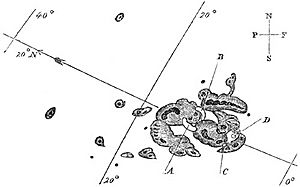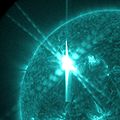Solar flare facts for kids
A solar flare or solar limb is a sudden brightening observed over the Sun's surface. It is a large energy release of up to 6 × 1025 joules of energy. The energy is about a sixth of the total energy that is released from the Sun each second or 160,000,000,000 megatons of TNT. It can also be compared with the impact of Comet Shoemaker-Levy 9 with Jupiter. The release is then followed by a colossal coronal mass ejection also known as a CME (coronal mass ejection). The first flare releases clouds of electrons, ions, and atoms through the corona of the Sun into space. These clouds usually reach planet Earth a day or two after this has happened. A solar flare is sometimes referred to another phenomena in other stars, such as stellar flare.
Solar flares affect all layers of the solar atmosphere such as the photosphere, chromosphere, and corona. Solar flares produce radiation across the electromagnetic spectrum at all wavelengths from radio waves to gamma rays. Most of the energy goes to frequencies outside it's range and because of this most of the flares cannot be seen by the naked eye. Solar flares are observed (looked at) with special instruments. Solar flares occur in active regions around sunspots. Solar flares are powered by the sudden release of magnetic energy that is stored in the corona. The same energy releases may produce coronal mass ejections (CME), although the relation between CMEs and flares is still not known.
X-rays and UV radiation that is released by solar flares can affect Earth's ionosphere. Because of this, radio communications, radars and other devices may be disrupted for a short time. Richard Christopher Carrington was the first person to observe a solar flare in 1859. Carrington had spotted brightening's of small areas within a sunspot group. Stellar flares have also been observed on several of other stars. Solar flares can be "active" from several flares a day or "quiet" from several flares every week. Solar flares occurs during the 11-year cycle (the solar cycle). There are less "large flares" than smaller ones.
Contents
Cause
Flares occur when accelerated charged particles, mainly electrons, interact with the plasma medium. Evidence suggests that the phenomenon of magnetic reconnection leads to this extreme acceleration of charged particles. On the Sun, magnetic reconnection may happen on solar arcades – a series of closely occurring loops following magnetic lines of force. These lines of force quickly reconnect into a lower arcade of loops leaving a helix of magnetic field unconnected to the rest of the arcade. The sudden release of energy in this reconnection is the origin of the particle acceleration. The unconnected magnetic helical field and the material that it contains may violently expand outwards forming a coronal mass ejection. This also explains why solar flares typically erupt from active regions on the Sun where magnetic fields are much stronger.
Although there is a general agreement on the source of a flare's energy, the mechanisms involved are still not well understood. It is not clear how the magnetic energy is transformed into the kinetic energy of the particles, nor is it known how some particles can be accelerated to the GeV range (109 electron volt) and beyond. There are also some inconsistencies regarding the total number of accelerated particles, which sometimes seems to be greater than the total number in the coronal loop. Scientists are unable to forecast flares.
Effects
Terrestrial
X-rays and extreme ultraviolet radiation emitted by solar flares are absorbed by the daylight side of Earth's atmosphere and do not reach the Earth's surface. Therefore, solar flares pose no direct danger to humans on Earth. However, this absorption of high-energy electromagnetic radiation can temporarily increase the ionization of the upper atmosphere, which can interfere with short-wave radio communication, and can temporarily heat and expand the Earth's outer atmosphere. This expansion can increase drag on satellites in low Earth orbit, which can lead to orbital decay over time.
Radio blackouts
The temporary increase in ionization of the daylight side of Earth's atmosphere, in particular the D layer of the ionosphere, can interfere with short-wave radio communications that rely on its level of ionization for skywave propagation. Skywave, or skip, refers to the propagation of radio waves reflected or refracted off of the ionized ionosphere. When ionization is higher than normal, radio waves get degraded or completely absorbed by losing energy from the more frequent collisions with free electrons.
The level of ionization of the atmosphere correlates with the strength of the associated solar flare in soft X-ray radiation. The NOAA classifies radio blackouts by the peak soft X-ray intensity of the associated flare.
| Classification | Associated solar flare | Description |
|---|---|---|
| R1 | M1 | Minor radio blackout |
| R2 | M5 | Moderate radio blackout |
| R3 | X1 | Strong radio blackout |
| R4 | X10 | Severe radio blackout |
| R5 | X20 | Extreme radio blackout |
Magnetic crochet
The increased ionization of the D and E layers of the ionosphere caused by large solar flares increases the electrical conductivity of these layers allowing for the flow of electric currents. These ionospheric currents induce a magnetic field which can be measured by ground-based magnetometers. This phenomenon is known as a magnetic crochet or solar flare effect (SFE). The former name derives from its appearance on magnetometers resembling a crochet hook. These disturbances are on the order of a few nanoteslas, which is relatively minor compared to those induced by geomagnetic storms.
In space
For astronauts in low earth orbit an expected radiation dose from the electromagnetic radiation emitted during a solar flare is about 0.05 gray, which is not immediately lethal on its own. Of much more concern for astronauts is the particle radiation associated with solar particle events.
Observations
Flares produce radiation across the electromagnetic spectrum, although with different intensity. They are not very intense in visible light, but they can be very bright at particular spectral lines. They normally produce bremsstrahlung in X-rays and synchrotron radiation in radio.
History
Optical observations
Solar flares were first observed by Richard Carrington and Richard Hodgson independently on 1 September 1859 by projecting the image of the solar disk produced by an optical telescope through a broad-band filter. It was an extraordinarily intense white light flare, a flare emitting a high amount of light in the visual spectrum.
Since flares produce copious amounts of radiation at H-alpha, adding a narrow (≈1 Å) passband filter centered at this wavelength to the optical telescope allows the observation of not very bright flares with small telescopes. For years Hα was the main, if not the only, source of information about solar flares. Other passband filters are also used.
Radio observations
During World War II, on February 25 and 26, 1942, British radar operators observed radiation that Stanley Hey interpreted as solar emission. Their discovery did not go public until the end of the conflict. The same year Southworth also observed the Sun in radio, but as with Hey, his observations were only known after 1945. In 1943, Grote Reber was the first to report radioastronomical observations of the Sun at 160 MHz. The fast development of radioastronomy revealed new peculiarities of the solar activity like storms and bursts related to the flares. Today ground-based radiotelescopes observe the Sun from c. 15 MHz up to 400 GHz.
Space telescopes
Because the Earth's atmosphere absorbs much of the electromagnetic radiation emitted by the Sun with wavelengths shorter than 300 nm, space-based telescopes allowed for the observation of solar flares in previously unobserved high-energy spectral lines. Since the 1970s, the GOES series of satellites have been continuously observing the Sun in soft X-rays, and their observations have become the standard measure of flares, diminishing the importance of the H-alpha classification. Additionally, space-based telescopes allow for the observation of extremely long wavelengths—as long as a few kilometres—which cannot propagate through the ionosphere.
Examples of large solar flares
The most powerful flare ever observed is thought to be the flare associated with the 1859 Carrington Event. While no soft X-ray measurements were made at the time, the magnetic crochet associated with the flare was recorded by ground-based magnetometers allowing the flare's strength to be estimated after the event. Using these magnetometer readings, its soft X-ray class has been estimated to be greater than X10. The soft X-ray class of the flare has also been estimated to be around X50.
In modern times, the largest solar flare measured with instruments occurred on 4 November 2003. This event saturated the GOES detectors, and because of this its classification is only approximate. Initially, extrapolating the GOES curve, it was estimated to be X28. Later analysis of the ionospheric effects suggested increasing this estimate to X45. This event produced the first clear evidence of a new spectral component above 100 GHz.
Other large solar flares also occurred on 2 April 2001 (X20+), 28 October 2003 (X17.2+ and 10), 7 September 2005 (X17), 9 August 2011 (X6.9), 7 March 2012 (X5.4), and 6 September 2017 (X9.3).
Prediction
Current methods of flare prediction are problematic, and there is no certain indication that an active region on the Sun will produce a flare. However, many properties of sunspots and active regions correlate with flaring. For example, magnetically complex regions (based on line-of-sight magnetic field) called delta spots produce the largest flares. A simple scheme of sunspot classification due to McIntosh, or related to fractal complexity is commonly used as a starting point for flare prediction. Predictions are usually stated in terms of probabilities for occurrence of flares above M- or X-class within 24 or 48 hours. The U.S. National Oceanic and Atmospheric Administration (NOAA) issues forecasts of this kind. MAG4 was developed at the University of Alabama in Huntsville with support from the Space Radiation Analysis Group at Johnson Space Flight Center (NASA/SRAG) for forecasting M- and X-class flares, CMEs, fast CME, and Solar Energetic Particle events. A physics-based method that can predict imminent large solar flares was proposed by Institute for Space-Earth Environmental Research (ISEE), Nagoya University.
Images for kids
-
An X5.4-class solar flare causing blooming, vertical streaking, and diffraction patterns to form in the image taken by the 131 Å (13.1 nm) sensor aboard the Solar Dynamics Observatory on 6 March 2012
See also
 In Spanish: Erupción solar para niños
In Spanish: Erupción solar para niños






